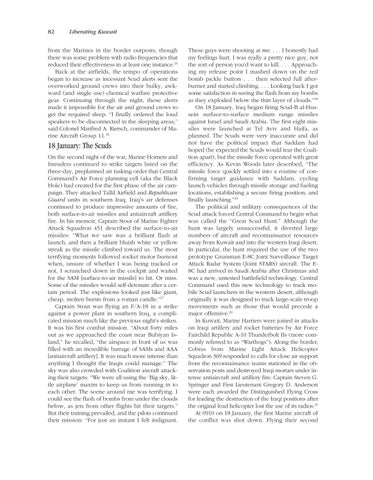82
Liberating Kuwait
from the Marines in the border outposts, though there was some problem with radio frequencies that reduced their effectiveness in at least one instance.15 Back at the airfields, the tempo of operations began to increase as incessant Scud alerts sent the overworked ground crews into their bulky, awkward (and single use) chemical warfare protective gear. Continuing through the night, these alerts made it impossible for the air and ground crews to get the required sleep. “I finally ordered the loud speakers to be disconnected in the sleeping areas,” said Colonel Manfred A. Rietsch, commander of Marine Aircraft Group 11.16
18 January: The Scuds On the second night of the war, Marine Hornets and Intruders continued to strike targets listed on the three-day, preplanned air tasking order that Central Command’s Air Force planning cell (aka the Black Hole) had created for the first phase of the air campaign. They attacked Tallil Airfield and Republican Guard units in southern Iraq. Iraq’s air defenses continued to produce impressive amounts of fire, both surface-to-air missiles and antiaircraft artillery fire. In his memoir, Captain Stout of Marine Fighter Attack Squadron 451 described the surface-to-air missiles: “What we saw was a brilliant flash at launch, and then a brilliant bluish white or yellow streak as the missile climbed toward us. The most terrifying moments followed rocket motor burnout when, unsure of whether I was being tracked or not, I scrunched down in the cockpit and waited for the SAM [surface-to-air missile] to hit. Or miss. Some of the missiles would self-detonate after a certain period. The explosions looked just like giant, cheap, molten bursts from a roman candle.”17 Captain Stout was flying an F/A-18 in a strike against a power plant in southern Iraq, a complicated mission much like the previous night’s strikes. It was his first combat mission. “About forty miles out as we approached the coast near Bubiyan Island,” he recalled, “the airspace in front of us was filled with an incredible barrage of SAMs and AAA [antiaircraft artillery]. It was much more intense than anything I thought the Iraqis could manage.” The sky was also crowded with Coalition aircraft attacking their targets: “We were all using the ‘Big sky, little airplane’ maxim to keep us from running in to each other. The scene around me was terrifying. I could see the flash of bombs from under the clouds below, as jets from other flights hit their targets.” But their training prevailed, and the pilots continued their mission: “For just an instant I felt indignant.
These guys were shooting at me. . . . I honestly had my feelings hurt. I was really a pretty nice guy, not the sort of person you’d want to kill. . . . Approaching my release point I mashed down on the red bomb pickle button . . . then selected full afterburner and started climbing. . . . Looking back I got some satisfaction in seeing the flash from my bombs as they exploded below the thin layer of clouds.”18 On 18 January, Iraq began firing Scud-B al-Hussein surface-to-surface medium range missiles against Israel and Saudi Arabia. The first eight missiles were launched at Tel Aviv and Haifa, as planned. The Scuds were very inaccurate and did not have the political impact that Saddam had hoped (he expected the Scuds would tear the Coalition apart), but the missile force operated with great efficiency. As Kevin Woods later described, “The missile force quickly settled into a routine of confirming target guidance with Saddam, cycling launch vehicles through missile storage and fueling locations, establishing a secure firing position, and finally launching.”19 The political and military consequences of the Scud attack forced Central Command to begin what was called the “Great Scud Hunt.” Although the hunt was largely unsuccessful, it diverted large numbers of aircraft and reconnaissance resources away from Kuwait and into the western Iraqi desert. In particular, the hunt required the use of the two prototype Grumman E-8C Joint Surveillance Target Attack Radar System (Joint STARS) aircraft. The E8C had arrived in Saudi Arabia after Christmas and was a new, untested battlefield technology. Central Command used this new technology to track mobile Scud launchers in the western desert, although originally it was designed to track large-scale troop movements such as those that would precede a major offensive.20 In Kuwait, Marine Harriers were joined in attacks on Iraqi artillery and rocket batteries by Air Force Fairchild Republic A-10 Thunderbolt IIs (more commonly referred to as “Warthogs”). Along the border, Cobras from Marine Light Attack Helicopter Squadron 369 responded to calls for close air support from the reconnaissance teams stationed in the observation posts and destroyed Iraqi mortars under intense antiaircraft and artillery fire. Captain Steven G. Springer and First Lieutenant Gregory D. Anderson were each awarded the Distinguished Flying Cross for leading the destruction of the Iraqi positions after the original lead helicopter lost the use of its radios.21 At 0910 on 18 January, the first Marine aircraft of the conflict was shot down. Flying their second











































